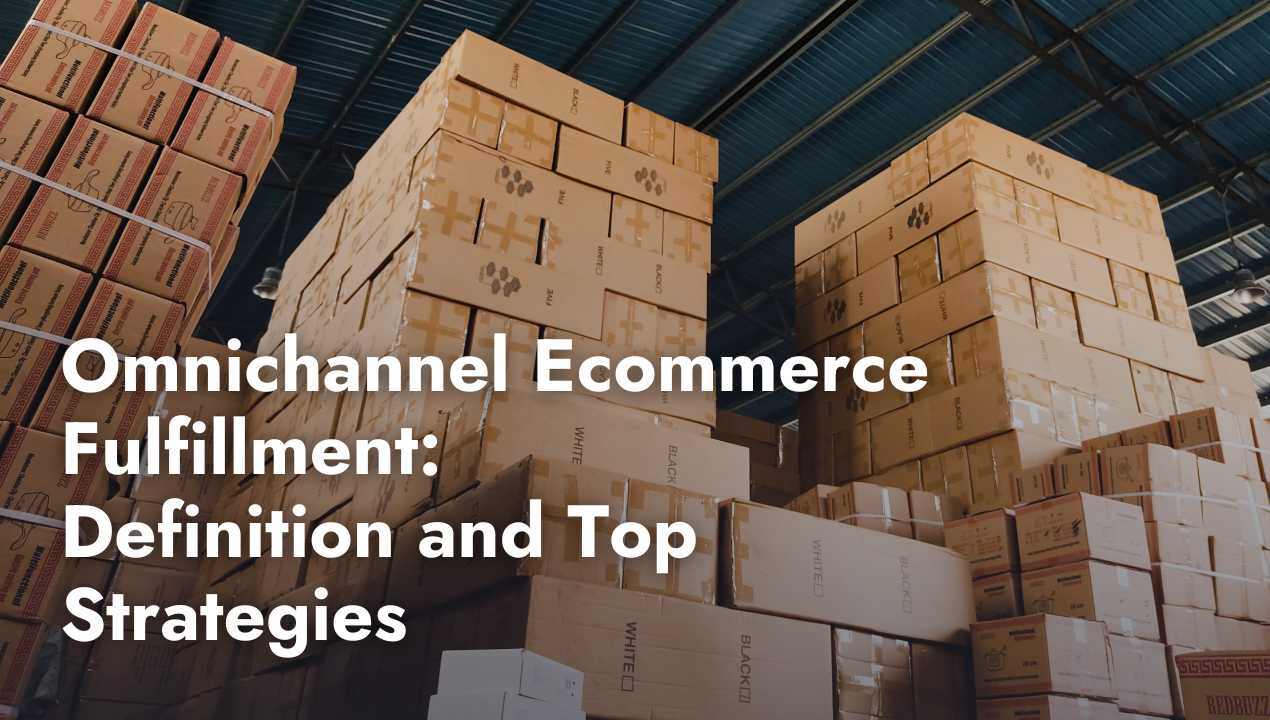Share this
How to Maximize the Customer Experience In Ecommerce
by Shipfusion Team on Mar. 26, 2025

The ecommerce space is crowded, and customer experience is a key differentiator. With competitors just a click away, seamless interactions, fast fulfillment, and personalized engagement can mean the difference between repeat business and abandoned carts. Every touchpoint matters, from the ease of navigation to how efficiently a package arrives at a customer’s doorstep. A well-executed customer experience strategy builds loyalty, reduces churn, and increases revenue. This article explores various strategies to enhance customer experience in ecommerce, ensuring your business not only survives but thrives in the face of staunch competition.
Defining Customer Experience In Ecommerce
Customer experience in ecommerce isn’t just about a polished website—it spans every interaction a shopper has with your brand, from product discovery to post-purchase support. A frictionless experience increases conversions, fosters loyalty, and encourages positive word-of-mouth marketing. Conversely, a slow website, unclear shipping policies, or poor customer service can send shoppers elsewhere.
Why Customer Experience In Ecommerce Matters A seamless experience isn’t a luxury—it’s an expectation. Research shows that 32% of customers will stop doing business with a brand after just one bad experience. With ecommerce growth driven by convenience, businesses must focus on reducing friction and exceeding expectations.
Essential Components of an Exceptional Ecommerce Experience
A great customer experience is built on key elements that directly impact satisfaction and retention:
1. Website Performance and Navigation
A slow, difficult-to-navigate website leads to frustration and lost sales. Optimize loading times, streamline the checkout process, and ensure mobile responsiveness. Google cites research that a one-second delay in page load time can reduce conversions by 7%, making speed optimization a priority. Implement intuitive search functionality and clear category structures to help customers find products quickly.
2. Personalized Shopping Experiences
Personalization enhances engagement and drives sales. Using customer data, businesses can offer tailored product recommendations, targeted promotions, and dynamic pricing. For example, Amazon’s AI-driven recommendations contribute to approximately 35% of its total sales. You too can leverage tools like AI chatbots, automated email campaigns, and behavioral tracking to provide personalized touchpoints throughout the shopping journey.
3. Seamless Checkout and Payment Options
High cart abandonment rates are often due to friction at checkout. Minimize steps, offer guest checkout, and provide multiple payment options, including digital wallets like Apple Pay and Google Pay. Transparency in pricing, shipping fees, and return policies also builds trust and reduces last-minute hesitations.
4. Reliable Order Fulfillment and Fast Shipping
Fast, accurate fulfillment is essential. In an era where two-day shipping has become standard, delayed or incorrect deliveries damage brand reputation. Partnering with a reliable third-party logistics (3PL) company like Shipfusion ensures efficient inventory management, accurate order processing, and expedited shipping to meet customer expectations.
5. Proactive Customer Support
Support should be accessible and efficient. Offering 24/7 chatbots, self-service knowledge bases, and responsive email and phone support gives customers multiple ways to resolve issues. Implementing AI-driven tools can help answer common queries instantly, while well-trained human support ensures complex problems are handled with care.
Strategies to Elevate Customer Experience
Improving customer experience isn’t a one-time effort—it requires continuous optimization and adaptation to consumer behavior. Businesses must implement actionable strategies that not only enhance customer interactions but also streamline operational processes.
Optimize for Mobile Shopping
With mobile commerce accounting for over 60% of global ecommerce sales, businesses must prioritize mobile-friendly experiences. Mobile optimization ensures that customers can browse, add to cart, and checkout seamlessly on any device. Key strategies include:
Responsive Design: A responsive website automatically adjusts to different screen sizes, improving usability on smartphones and tablets.
One-Click Checkout: Simplify mobile payments with tools like Apple Pay and Google Pay, reducing checkout friction.
Accelerated Mobile Pages (AMP): AMP improves page load speed on mobile devices, reducing bounce rates and improving engagement.
Invest In Post-Purchase Engagement
The customer journey doesn’t end at checkout. Post-purchase engagement helps retain customers and increases lifetime value.
Effective strategies include:
Automated Order Updates: Keep customers informed with real-time tracking and estimated delivery dates.
Loyalty and Rewards Programs: Incentivize repeat purchases with exclusive discounts, rewards points, or VIP memberships.
Personalized Follow-Up Emails: A simple "Thank you for your purchase" email with product recommendations based on past behavior can encourage additional sales.
Implement a Hassle-Free Returns Process
A difficult return process can deter shoppers from making future purchases. A seamless reverse logistics process builds trust and encourages repeat business.
Best practices include:
Clear Return Policies: Clearly outline eligibility, timeframes, and return methods on product pages.
Prepaid Return Labels: Providing easy return shipping options simplifies the process for customers.
Instant Refunds or Store Credit: Quick refunds reduce customer frustration and encourage future purchases.
Leverage Customer Data for Personalization
Customers expect brands to understand their preferences. Data-driven personalization enhances customer engagement.
Strategies include:
AI-Powered Product Recommendations: Use browsing history and purchase behavior to suggest relevant products.
Targeted Email Campaigns: Personalized subject lines and dynamic content increase open rates and conversions.
Behavioral Retargeting: Display relevant ads to users who browsed but didn’t purchase, reminding them of products they showed interest in.
Enhance Customer Support with AI and Human Assistance
Fast, efficient support is a cornerstone of a great customer experience. Combining AI-powered tools with human customer service improves responsiveness.
Consider these tactics:
AI Chatbots for Instant Responses: Chatbots handle common inquiries, freeing agents for complex issues.
Omnichannel Support: Offer live chat, phone support, social media messaging, and email assistance.
Customer Self-Service Portals: FAQs, video tutorials, and community forums empower customers to find answers quickly.
Utilize Social Proof and User-Generated Content
Customer trust is built through authenticity. Encourage satisfied customers to share their experiences through:
Reviews and Ratings: Display customer feedback prominently on product pages.
User-Generated Photos and Videos: Customers showcasing products in real-world settings increase credibility.
Social Media Engagement: Feature customer testimonials on Instagram, TikTok, and Facebook to build community trust.
Future Trends Shaping Ecommerce Customer Experience
Expectations for the customer experience in ecommerce are changing. Below, we highlight just three areas worth focusing on over the years to come.
AI-Driven Shopping Experiences
Artificial intelligence is enhancing product recommendations, predictive analytics, and automated customer interactions. AI-powered chatbots can handle up to 80% of routine inquiries, freeing human agents for complex issues.
Omnichannel Consistency
Shoppers expect a seamless experience across online stores, social media, and marketplaces. Integrated inventory management and real-time data synchronization ensure consistency across all sales channels.
Sustainability and Ethical Shopping
Consumers increasingly prefer brands with eco-friendly packaging, ethical sourcing, and carbon-neutral shipping. Highlighting sustainability initiatives can influence purchase decisions and build brand loyalty.
Ready to Elevate Your Ecommerce Fulfillment?
Maximizing customer experience doesn’t end with your website—it extends to the delivery of your products. Shipfusion is here to ensure that your fulfillment process contributes to your success. As your trusted 3PL partner, we offer seamless all-in-one fulfillment services that scale with your business. With Shipfusion, you can guarantee that your customers receive their orders promptly and accurately, enhancing their overall shopping experience.
Get pricing today and take the first step toward a fulfillment solution that supports your ecommerce growth.**
Share this
You May Also Like
These Related Articles

Omnichannel Ecommerce Fulfillment: Definition and Top Strategies

Top Ecommerce Key Performance Indicators to Track for Business Success

How to Find the Right Ecommerce Marketplaces for Your Business
- April 2025 (18)
- March 2025 (26)
- February 2025 (26)
- January 2025 (37)
- December 2024 (16)
- November 2024 (23)
- October 2024 (22)
- September 2024 (27)
- August 2024 (9)
- July 2024 (8)
- June 2024 (5)
- May 2024 (8)
- April 2024 (8)
- March 2024 (6)
- February 2024 (6)
- January 2024 (5)
- December 2023 (3)
- November 2023 (3)
- October 2023 (5)
- September 2023 (4)
- August 2023 (2)
- July 2023 (1)
- June 2023 (4)
- March 2023 (2)
- October 2022 (1)
- September 2022 (5)
- August 2022 (4)
- July 2022 (7)
- June 2022 (4)
- May 2022 (4)
- April 2022 (6)
- March 2022 (2)
- February 2022 (1)
- January 2022 (3)
- December 2021 (2)
- November 2021 (4)
- October 2021 (2)
- September 2021 (5)
- August 2021 (4)
- July 2021 (4)
- June 2021 (3)
- May 2021 (2)
- April 2021 (3)
- March 2021 (3)
- February 2021 (3)
- January 2021 (2)
- December 2020 (4)
- November 2020 (2)
- October 2020 (4)
- September 2020 (2)
- July 2020 (5)
- June 2020 (4)
- May 2020 (2)
- April 2020 (2)
- March 2020 (4)
- February 2020 (1)
- December 2019 (1)
- May 2018 (1)
- March 2018 (2)
- February 2018 (3)
- January 2018 (3)
- November 2017 (3)
- July 2017 (4)
- March 2017 (3)
- February 2017 (5)
- January 2017 (3)
- December 2016 (4)
- November 2016 (6)
- October 2016 (6)
- October 2015 (1)
- September 2015 (1)
- June 2015 (3)
- May 2015 (3)
- August 2014 (1)
- July 2014 (1)
- March 2014 (1)
- February 2014 (1)